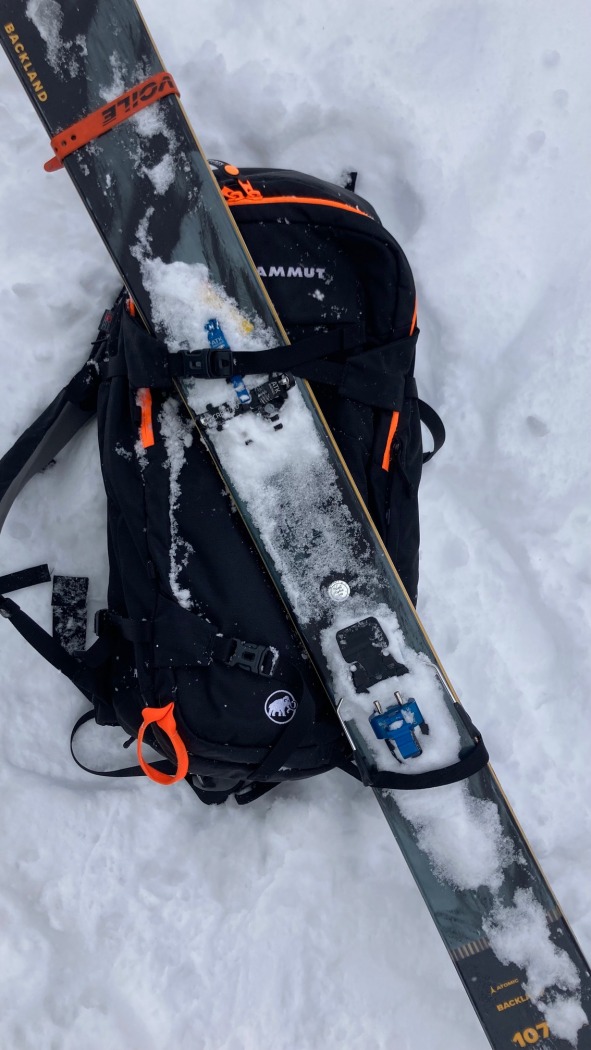
The Mammut Pro Removable Airbag 3.0 is a full featured 45L airbag pack ready to journey with you on the big hauls.
The back and forth, the should or shouldn’t I — we’re talking about wearing an avalanche airbag pack— is best left for another article. I will say that I’ve come to the personal conclusion that a beacon and avalanche pack are vastly different tools. The beacon allows me to search for a potentially buried partner, and I’ll transmit a signal if buried. Ideally, if caught in a slide, the airbag pack prevents burial.
Over the next few months, we’ll be looking at a few different avalanche airbag packs with slightly different feature sets and deployment systems. Already lined up for the exam are the Ortovox Litric Freeride 28, BCA’s Float 28 E2 (both new electric systems coming online Fall 22′), ARVA’s UL 26 canister pack, and Mammut’s Pro Removable Airbag 3.0, which I refer to as the Pro Removable 45L. If you’ve got specific questions about these packs, fire them off so we can include your virtual eyes in the assessment.
For most of the winter, I’ve had the Pro Removable 45L and used it both with the full 3.0 canister system installed and without. Remove the airbag system, and you have a high functioning voluminous 45L pack suitable for hut-to-hut missions or long mid-winter frigid day trips when extra layers are needed. The truth is, I could write the same of the pack with the entire 3.0 system (including the canister) installed. The big difference is that you’re hefting an extra 1298g or 2.86 pounds (trigger/airbag/canister interface 696g + canister 602g) with the entire system in place.
Weight entire system: 1298g
Weight pack alone: 1654g
Weight pack+ entire airbag system: 2952g
Compare to weights of other airbag packs. The Mammut Pro Removable 45L is the highest volume pack in the linked database.
Last September, Roger Romani reviewed the Black Diamond Jetforce UL 26 avalanche airbag pack. He began the review by asking, “Why doesn’t everyone ride with an avalanche airbag?” He answered by stating the heavy weight, expense, and lackluster backpack performance compared to “non-inflatable brethren” as the primary deterrents.
If we surveyed the community, the chorus would likely raise the same concerns. Although we still rely on the trifecta of beacon, shovel, probe (I’m adding a helmet), the broader backcountry ski/ride culture appears to be in the early phase of adopting avalanche airbags as de facto safety gear. It’s a personal decision. Yet, I think I’m now in a mindset where without an avalanche bag during the winter, I feel exposed. For me it’s like when I first formed the habit of wearing a helmet years ago and then spaced the lid on a tree skiing day. All I could imagine was the impact.
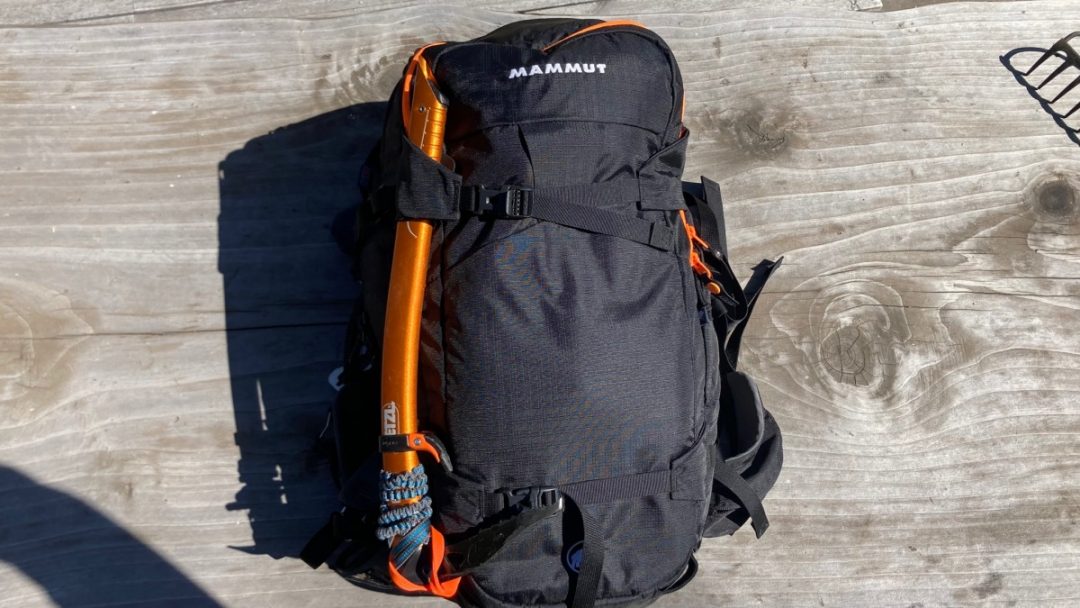
The pack is designed to carry a single axe externally.
Let’s address the price first. The Mammut Pro Removable 45L costs $669.95 and comes in one size. Add on another $150-$190 for the sold-separately aluminum canister (no carbon available in the U.S. and Canada for the moment) which includes three cartridges. Once you own the aluminum canister and burn through the cartridges, it’s $17.95 for three replacement cartridges. As covered heavily on WildSnow, as a canister pack, practicing a near real-world scenario by pulling the trigger with a pressurized canister attached ultimately requires refilling the canister and replacing the cartridge with each use. For a canister refill, you can pay to have it repressurized at a local shop. Or do as I did: spend roughly thirty minutes manually pressurizing the canister to 3000psi (there’s an easy-to-read pressure gauge on the Snowpulse canister system). I know I made good spectator sport pumping away, it wasn’t easy. The pack comes with a trigger test tool for more carefree trigger practice–no repressurizing or airbag repacking required.
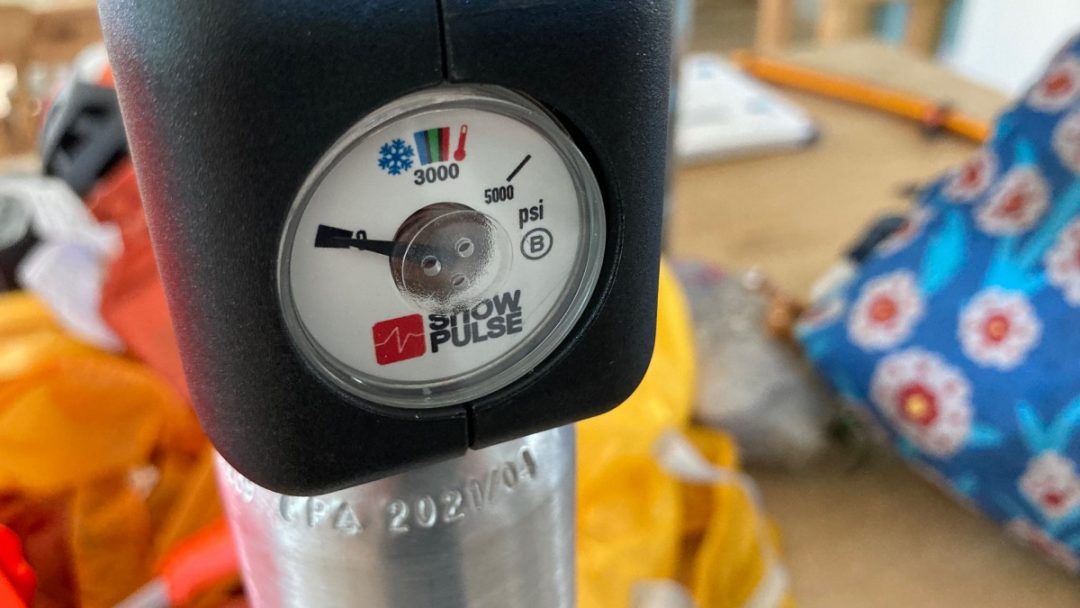
Easy to read pressure gauge- one part of the Snowpulse system. Thirty minutes of pumping, including a solid core workout, will fill this canister manually.
The Pack
Let’s get to pack functionality. In mid-winter, I usually use a 38-liter pack. With or without the 3.0 system installed, I had ample room for my usual arsenal of layers, mittens, gloves, and two liters of water with the Pro Removable 45L.
Access to the main compartment is through a traditional clamshell opening (zippers run roughly ½ down the pack’s length) or by unzipping the foam/plastic reinforced back panel. Lay the pack down on the snow, and it’s easy to access the entire main compartment via this panel. In a pack this size, in which you likely carry plenty of stuff, this feature comes in handy. It’s also useful for photographers who desire an airbag pack and quick access to lenses.
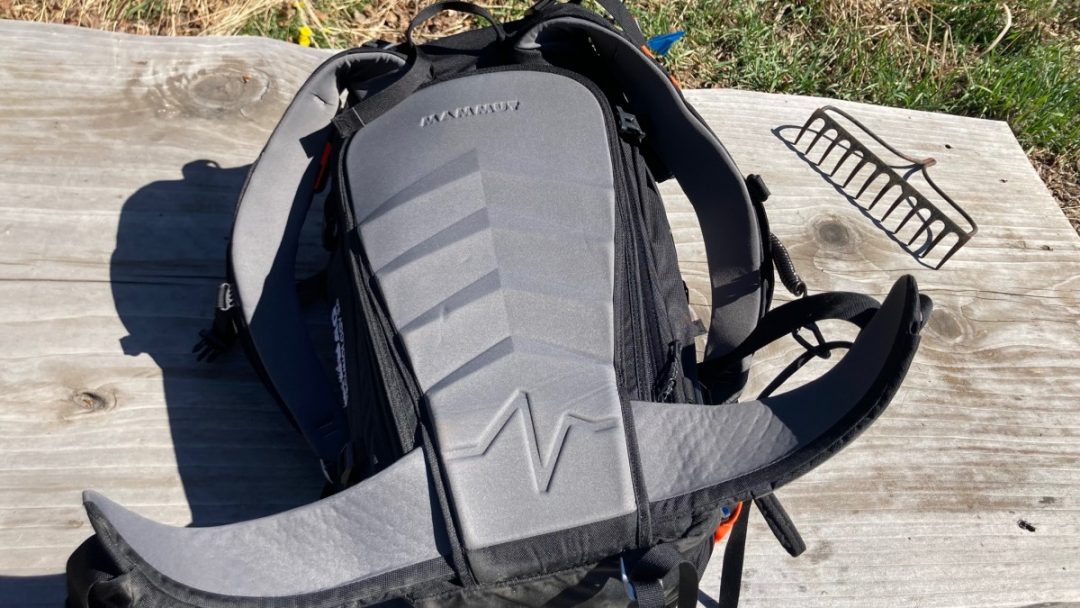
The packs features a well padded waistbelt and shoulder straps——the backpanel opens with the u-shaped zipper.
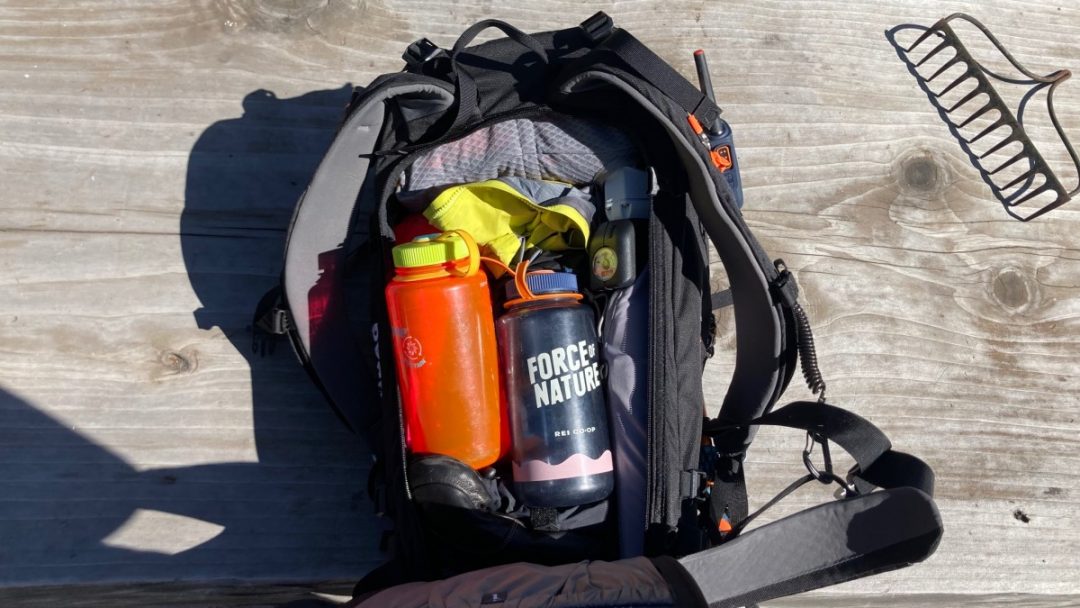
With the back panel open, full access to the main compartment is easy.
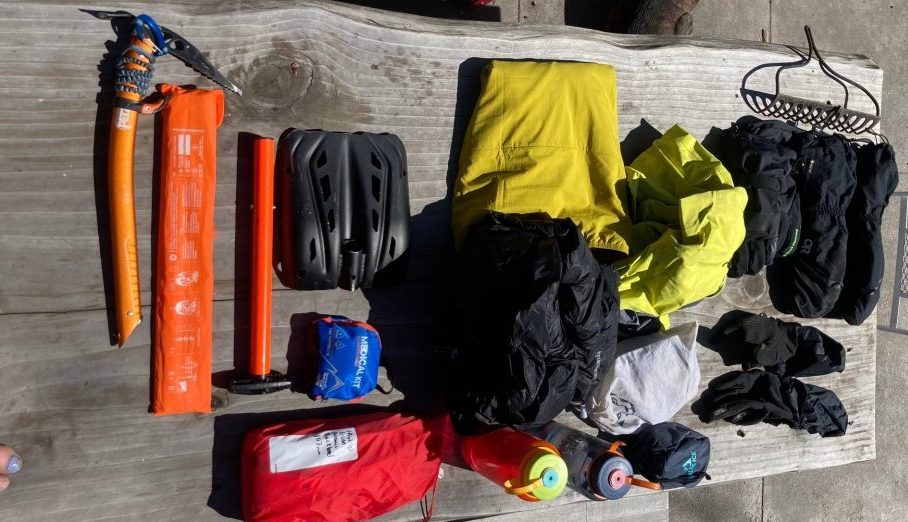
All the goods that fit nicely into the 45L pack with the entire airbag system installed. Items include an axe, probe, shovel, skins, first-aid kit, two Nalgene bottles (1L/each), insulated vest, puffy, hard shell jkt., food bag, crampons, liner gloves, mittens, insulated gloves.
The main compartment includes a hydration sleeve and a path to route a tube internally through to the left shoulder strap. A zipper runs the length of the left shoulder strap; unzip, and you can access the hydration tube, or stash a small collapsible water flask (no larger than 500ml) or small plastic bottle in a stretchy pouch. Not to be left out, near the top of the cavernous main compartment sits a small zippered mesh pocket to organize keys and other small doodads like skin wax and a few bars. Of the 45 claimed liters of volume, I’d say all but three of those liters are usable for storage with the airbag system installed.
For the beacon, shovel, and probe, the pack includes a robust and day-glo orange safety pocket; the zippers for the safety pocket sport the orange color too.
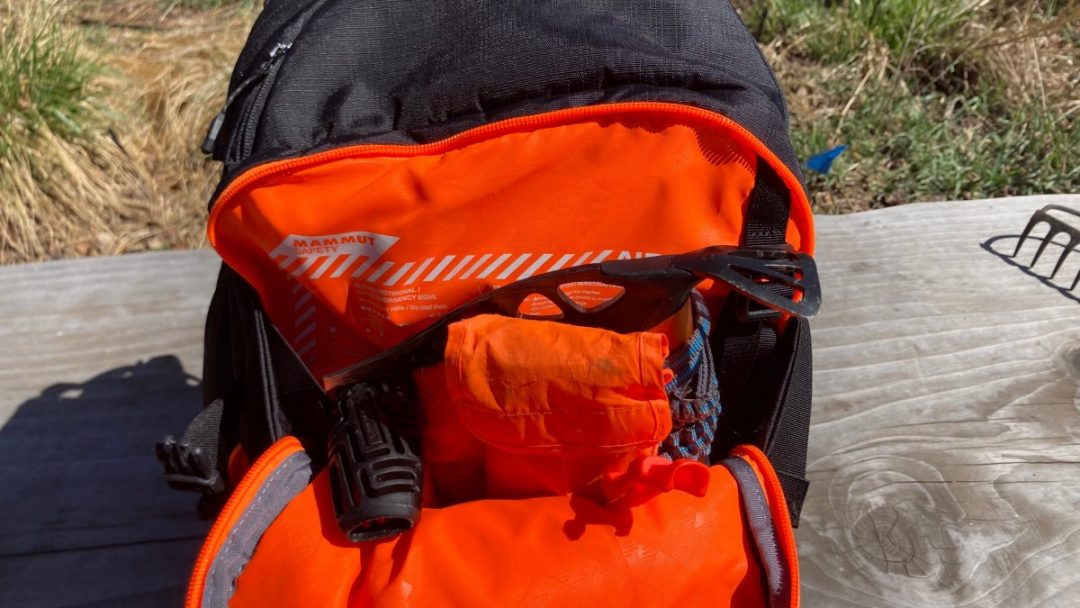
The safety pocket is day-glo orange and has room for a shovel handle, shovel blade, full-size probe, a small axe, and if you carry a snow study kit, it will accommodate that too.
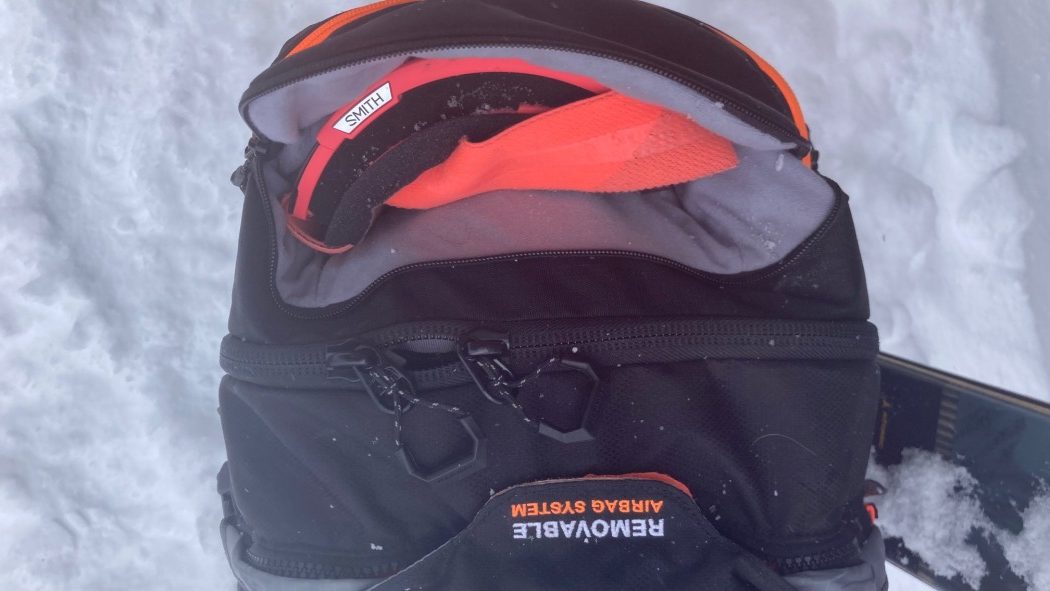
Up near the top is a generously sized, well protected, fleece-lined goggle pocket.
Other add-ons include a generous fleece-lined goggle pocket, a stowable helmet carry, a hip belt with a gear loop (left side), and a small pocket (right side). The hip belt is well padded, supportive enough for a hefty 45L load, and is removable. Like many airbag packs, the leg loop is secured by aluminum waist belt buckles. One small change I’d like to see is an orange-colored leg loop. If you forget to attach the leg loop before descending, in my opinion, it’s easier to see something orange dangling around than black.
When fully loaded and a pair of 183cm Atomic Backland 107s fixed to the diagonal ski carry system, the Pro Removable 45L rides securely as it is well supported by a thin aluminum U-frame. And despite its size, this pack skis like a well-designed ski pack. To piggyback on the words of Romani, the pack does perform as well as its non-inflatable brethren.

The pack is set up to carry skis diagonally. With the aluminum u-frame, the pack is both comfortable and carries it’s load well.
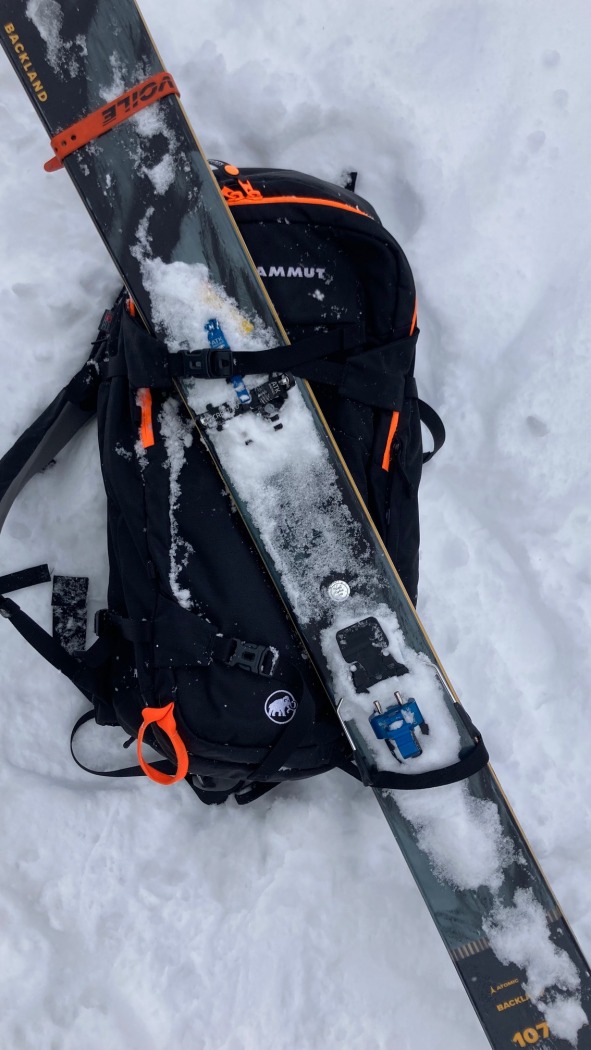
A close up of the diagonal ski carry system. The size of the lower loop is adjustable.
This pack is also designed to carry skis in an A-frame, but the basic recommendations are to carry skis diagonally, so the airbag’s inflation is unimpeded. (Meaning; do not A-frame carry in any terrain you might consider avalanche prone.) The A-frame carry comes in handy where avalanches are not a concern. For splitboarders, the carry system is simple; secure the board with adjustable horizontal straps on the pack’s backside. An external carry for a single smaller ice axe (50cm and smaller) is included. The safety pocket will accommodate another smaller axe; a Petzl Gully sits in there nicely.
I’ve gone back and forth on this, but I’ve settled on wanting a more refined axe carry system. I like the option to bring two light axes when the terrain calls for it. That’s doable with this pack, but it’s slightly more cumbersome to attach and remove the axes than on other packs like the Blue Ice Kume or the new BCA and Ortovox avy bags we’re testing.
The same might be said of the ski carry; it’s functional and secure, yet, inelegant.
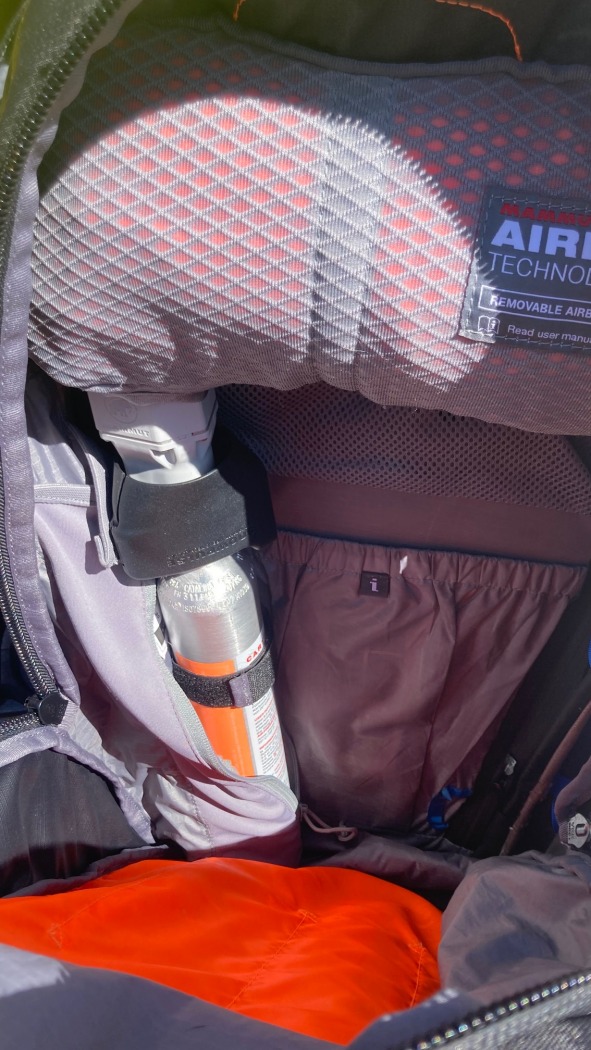
The full internal airbag system on display.
The 3.0 System
As the number suggests, the airbag system is further along in numerical value, 3.0, not 2.0. The 3.0 system is smaller and lighter than the older 2.0 system and has been available for several years. Again, the pack we reviewed is part of the RAS or removable airbag system. The airbag system in this pack is removable; you can use the system in any other Mammut RAS 3.0 airbag pack. Below are some of the RAS options listed on the Mammut website.
Light Removable Pack 30L $229.95.
Light Short Removable Pack 28L $229.95.
There are other packs in the RAS line, notably the Ultralight (20L) and Flip (22L), but, for now, I’m not seeing them for sale as stand-alone packs. The Removable Airbag System 3.0 is incompatible with older RAS 2.0 backpacks.
Note: Mammut’s pack nomenclature can get confusing. For example, there’s also the Pro Protection 35-45L Airbag 3.0 Backpack. This pack also has a removable inflation system and includes the trauma airbag.
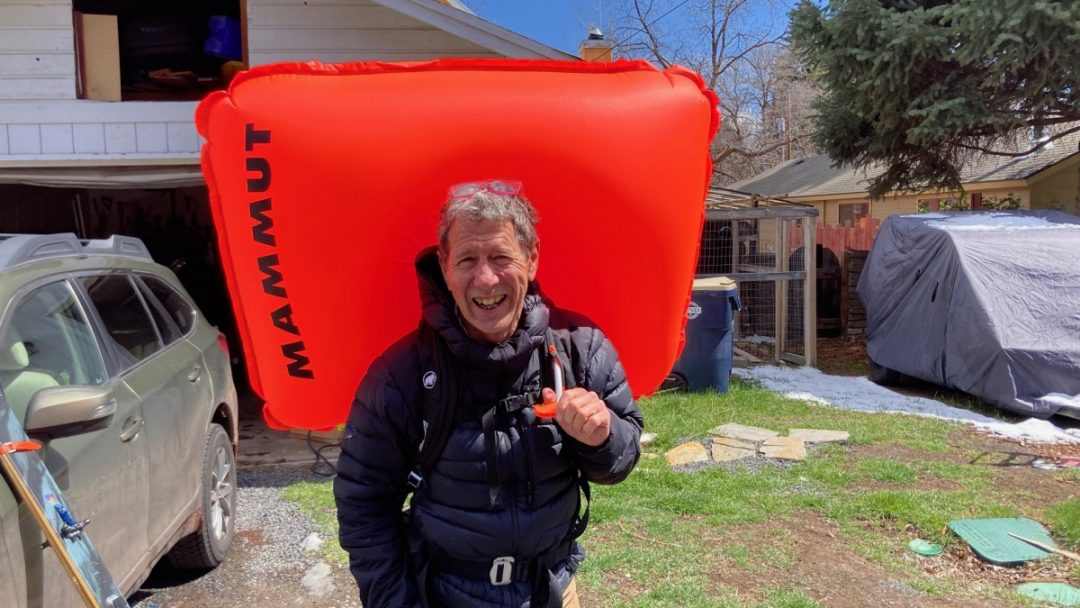
The 150L airbag delpoyed. It takes roughly three seconds for the bag to fill completely once the trigger is pulled.
The airbag included with the Pro 45L is not the trauma protection airbag. The trauma airbag envelopes more of the head and neck region to, as the name suggests, provide greater protection from blunt force trauma. The series of RAS packs from Mammut possess a traditional-looking balloon airbag meant more for buoyancy. The RAS airbag is 150L and inflates in approximately three seconds. Once deployed, repacking the airbag in the pack requires a specific set of folding instructions. If you’re like me, it may take a few times repacking to dial in the folding sequence. Thinking of sequences, removing, and reinstalling the inflation system also requires specific steps. It’s best to practice before heading out for a week-long hut trip or bring the instructional PDF loaded on your phone.
The Pro 45L is designed with the trigger fixed on the left shoulder strap. This accommodates right-handers more than lefties.
Arming the system is simple. Add a new cartridge to the canister, pressurize the canister, screw it into place, and secure it with a velcro strap and zippered pouch. According to Mammut, the system’s temperature range is –30 to +40 °C. You can often have canisters refilled at paintball suppliers and diving shops.
If flying with the pack, play it safe and secure a canister to use at your final destination.
Final thoughts
As a ski/ride pack, this is not some svelte alpinism-inspired item: It’s a workhorse that carries as well as any pack I’ve used, but it’s not the shiny new penny. The burly nylon fabric, thick straps, and beefy zippers mean greater weight, but it also means a pack that’s likely to be around for a decade. As for the inflation system, that too is likely to be functional for a decade. Yes, many avy manufacturers are investing in electronic systems, with some systems affording users multiple deployments on a single charge. Think of this pack and its airbag technology as the Toyota Tacoma of avy bags. There are slight improvements yearly, but the motor and suspension on older models do the job of off-roading, ski posse transport, and dirt-bagging.
But an avy airbag is safety gear and your life might depend on it. Like any engineered safety system, it’s probably best to regularly test the system. And as these airbag packs are more complex, familiarizing yourself from time to time with the zippers, pockets, trigger, etc., isn’t such a bad idea.
Initially, when picking up the pack with the airbag system installed, yes, you note the weight. It’s like I’ve got a liter of water in there even though I haven’t packed up yet. Once it’s on my back and I’m moving in the hills, the extra weight is negligible, even unnoticeable. I often wore the Pro Removeable 45L with, at least for me, a beefier setup in terms of boots, skis, and bindings. So gram counting wasn’t my primary concern.
All this is a substantial financial commitment upfront: roughly $860.00 in the case of the Pro Removeable 45L for the whole setup. Depending on how you break out your spending habits, that’s equivalent to bindings and skins, maybe skis (on sale) and skins? The bottom line is to make sure the pack and system are something you will use. An airbag you deem too heavy or a hassle in terms of functionality will sit in the closet, there’s no upside. For someone seeking a more traditional airbag system and plenty of volume to carry gear, the Pro Removeable 45L might be for you.
Jason Albert comes to WildSnow from Bend, Oregon. After growing up on the East Coast, he migrated from Montana to Colorado and settled in Oregon. Simple pleasures are quiet and long days touring. His gray hair might stem from his first Grand Traverse in 2000 when rented leather boots and 210cm skis were not the speed weapons he had hoped for. Jason survived the transition from free-heel kool-aid drinker to faster and lighter (think AT), and safer, are better.
